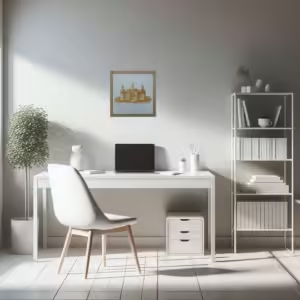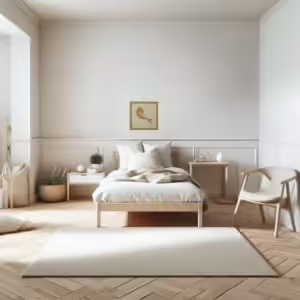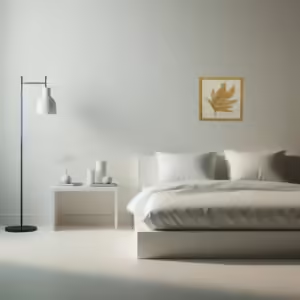- Description: Simplicity, clean lines, and a neutral color palette.
- Ideas: Frames with geometric or monochrome designs, staged with furniture featuring simple shapes.
The Minimalist Style: The Elegance of Simplicity
Minimalist style, synonymous with purity and simplicity, is an approach to interior design that emphasizes the essentials, eliminating everything superfluous. Inspired by the maxim “less is more,” this style has conquered the world of decor by offering a peaceful and uncluttered refuge in a world often filled with distractions. In this article, we will explore the foundations of minimalist style and discover how to adopt it to create a space that is both functional and aesthetically pleasing.

1. The Origins of Minimalist Style
Minimalist style has its roots in the artistic and architectural movements of the early 20th century, particularly modernism and Scandinavian design. It is also inspired by Japanese Zen, which advocates harmony, simplicity, and balance. This style gained popularity in the 1960s as a reaction to the excess and complexity of previous styles. Today, it embodies a philosophy of life where the focus is on essentials, functionality, and tranquility.

2. The Principles of Minimalism
Minimalism is based on a few key principles: simplicity, functionality, and aesthetics. Every element in a minimalist interior must have a clear purpose and contribute to the overall harmony. Clutter is avoided, and spaces are designed to be fluid and open. Decoration is reduced to the essentials, favoring clean lines, simple shapes, and a neutral color palette.

3. Colors: The Purity of Neutrals
The color palette in a minimalist interior is generally neutral, dominated by shades of white, gray, beige, and black. These colors create a serene backdrop and allow shapes and textures to stand out. White, in particular, is often used for its calming effect and ability to reflect light, helping to visually expand the space. Touches of color can be added but remain subtle and well-considered, often in the form of accessories or art pieces.

4. Materials: Excellence in Quality
Minimalist style prioritizes high-quality materials that stand on their own. Light wood, concrete, metal, and glass are commonly used for their simplicity and ability to create a modern and sophisticated atmosphere. Textures play a crucial role, adding warmth and depth without compromising visual simplicity. For example, smooth wooden floors, polished concrete surfaces, or stainless steel elements can add a tactile dimension while staying true to the minimalist spirit.

5. Furniture: Simple Forms and Functionality
Minimalist furniture is characterized by clean lines and simple geometric shapes. Each piece is carefully chosen for its functionality and ability to harmonize with the space. Multifunctional furniture, like sofa beds or extendable tables, is particularly appreciated for its utility and sleek design. Built-in storage, such as recessed cabinets or wall shelves, helps reduce visual clutter while maximizing available space.

6. Accessories: The Sobriety of Elegance
Accessories in a minimalist interior are reduced to the essentials, but each piece is carefully chosen for its visual impact. An abstract artwork, a sleek ceramic vase, or a sculptural lamp can become focal points without overwhelming the space. Lighting, in particular, plays a key role in minimalism, emphasizing natural light and using discreet fixtures to create a soft and soothing ambiance.

7. Embracing Minimalism at Home
Adopting minimalist style at home means choosing to live with less to appreciate more. To start, it is important to declutter your space, removing unnecessary items and keeping only those that have a function or special meaning. Opt for a neutral color palette and invest in quality materials and functional furniture. Finally, be selective with accessories, favoring those that add a touch of sophistication without disrupting the overall harmony.
